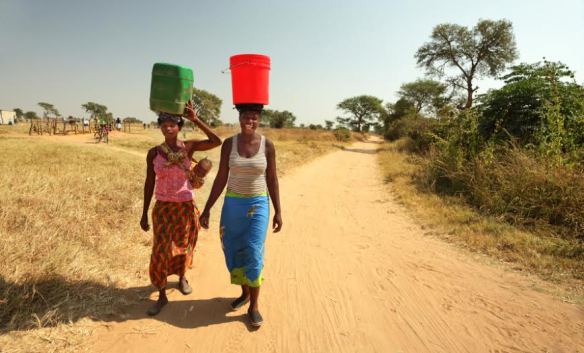By Mayesha Alam
Find the PDF version of this Information2Action Rapid Response here.
Water is essential to life on earth, but we are facing a global crisis. According to a new report released by UNESCO on March 22 to mark International Water Day, the world will face a 40 percent shortage in our water supply by 2030. This is an alarming problem that disproportionately affects women and girls.
In many places around the world where dependable irrigation is a distant dream and clean water a precious commodity, women and girls bear the primary burden of finding water. What they are able to carry on their heads and shoulders is then rationed carefully for drinking, cooking, cleaning and other livelihood needs. In fact, around the world, women and children spend 140 million hours per day collecting water for their families and communities, according to Water.org, and this results in their lost productive potential. For example, in many villages of India and Ethiopia, girls are kept out of school or fall behind on their studies because they are required to fetch water. This, in turn, contributes to child marriage and early pregnancy. For women in warzones, such as South Sudan, the often long and lonely journey of collecting water comes with very real physical dangers, including rape and kidnapping. For those who are forcibly displaced, either in their own countries or as refugees in foreign lands, lack of access to water or sanitation is one of the most significant challenges faced on a daily basis. Climate change is also exacerbating water shortage and women, who comprise the majority of the world’s agricultural labor force, must adapt to increased famines, droughts and flooding. Lack of adequate access to safe water and sanitation is also a key factor in maternal and child mortality, and is dramatically more pronounced in rural settings. In January 2015, the World Economic Forum identified water shortage as being the single greatest “Global Risk” based on its widespread societal effects.
But women and girls are not merely victims of this global crisis and nor should they be perceived as such. Increasing access to clean water would increase girls’ enrollments in school and their levels of literacy and education. In Ghana, researchers found that reducing the time a girl needs to spend gathering water by even a mere 15 minutes would increase her school attendance rate by 8 to 12 percent. Similarly, women would be able to spend that time working, providing for their families and contributing to economic growth. Inexpensive and bio-friendly tools would allow women and girls to become shepherds of environmental sustainability. Simple investments in increasing access to clean water and sanitation have the potential to reap multiple economic, social, health, and even political dividends. The World Health Organization estimates that every $1 spent on water and sanitation would reap a $4 monetary benefit. Moreover, ensuring universal access to water and basic sanitation would reduce unsafe water-borne sickness and associated healthcare costs, as well as increase output to grow the global economy by $32 billion.
This year marks the fifteenth anniversary since the adoption of the Millennium Development Goals, which were created to eradicate extreme poverty, as well as the twentieth anniversary of the UN Fourth World Conference on Women in Beijing. As we measure progress made, it is important to reflect on not only how far we’ve come, but also how far we have yet to go. For example, more people around the world own a cell phone than a toilet. Raising awareness coupled with greater access to credit, especially for women who have an extremely difficult time receiving loans or are unable to own property in many countries, represent cost-effective measures to improving irrigation and hygiene.
The simple truth is that without water, humanity cannot survive, just as without women, who constitute more than half the global population, humanity cannot thrive. Ensuring women’s empowerment is a critical ingredient to mitigate the risks of water insecurity. To create positive change, we will need political leadership, scientific innovation, environmental conservation and the full and equal participation of women.
Mayesha Alam is the Associate Director of the Georgetown Institute for Women, Peace and Security and the author of Women and Transitional Justice: Progress and Persistent Challenges (Palgrave Macmillan, 2014).













